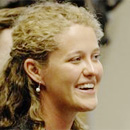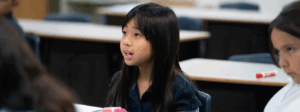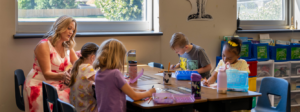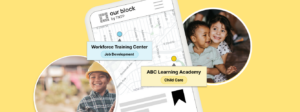Sarah Greer Osborne is Director of Communications at the Houston Independent School District (HISD), where she has helped lead a number of HISD’s strategies to engage teachers, principals, students, parents, and the Houston community. We sat down with her to learn more about her approach.
What is the role of the communications department in advancing HISD’s goals for kids?
A strong communications program helps all stakeholders—from families to teachers to district staff—become more engaged in ensuring our students succeed. Many of our initiatives affect teachers the most. We have 12,000 teachers. Making sure they’re on board and understand what we’re doing and why we’re doing it is a big part of our role.
We also spend a lot of time thinking up ways to help parents become more engaged in their child's education and understand that doesn't necessarily mean going to the school play. We help parents understand what they have access to, like the ability to check their child's grade online, or sign up for texts that tell them when their child is falling behind in class.
It's a struggle sometimes because a big portion of our parents work several jobs. Many of them are also Spanish speakers. Coming to parent night is really, really difficult for some. So we rely on different ways to engage them, like our Twitter account. We have over 60,000 followers, a lot of them parents and students. We use it to make important announcements and share our popular News Blog that runs three or four pieces a day about everything going on in the district and in our schools.
Can you tell us about a problem that was avoided because of effective communication from the district?
I have a good example with PowerUp, an initiative in which we gave our students 65,000 laptops. A big part of this was giving students a lesson about digital citizenship, their digital footprint, and what that all means. But the missing step was that, initially, there was no plan for a digital citizenship lesson for parents. I’m a mother of a 17-year-old. I know what kids do on the internet. I also know kids learn from their parents, so if we wanted our students to truly understand the importance of not posting inappropriate things on the internet, we had to include parents in the conversation.
On the night we gave the laptops out to parents, we spent an hour teaching them about digital citizenship and cyber safety. A lot of parents came away saying, “I didn’t know what a digital footprint is.” A lot of them also didn’t know that what their kids post online can affect what college they go to, or what job they can get.
It sounds like what you're describing is a responsiveness to needs that aren't exclusively communications related. Is that right?
Absolutely. In the end, we're shaping the lives and mindsets of children who are with us more than they are with their parents all day. It's not just academics. It's about the whole child. We have to play a part and we need to support their parents.
The “State of the Schools” is a big event you coordinate yearly to set the district’s agenda for the coming year in front of members of the community. Could you tell us more about the event and why it’s important?
The State of the Schools draws 2,000 people a year. We invite community partners, partners we may be trying to recruit, and businesses who help us with internships for students, externships for teachers, or scholarships. It’s an opportunity for us to show our partners what we're doing, but what we discovered is that when we make it about the kids and show what the kids are doing, it’s even better.
At this year’s event, we had a walk of fame in the foyer where students showed off what they're doing in the classroom. We had our 3D welding simulators out there. We had a twenty-five foot rocket they built. We had students accepted to Ivy League schools. People spent an hour before the event getting to know them. Events like these are important, but they have to be done in a certain way. If you just have a superintendent speaking to the community, it’s not very effective. The meat and potatoes is when people are interacting with the students and learning about what they're doing.
HISD just hired a new Superintendent. Did the communications team play a role in engaging parents and the community in order to choose the right candidate?
Yes. We spent a lot of time last year working with the community to figure out what qualities we wanted and needed in a new Superintendent. We gathered input from 3,200 parents and community members. In the end, we’re thrilled with the outcome. Superintendent Carranza is a fluent Spanish speaker who understands the communities we serve and is a lifelong educator who is committed to building a strong partnership with families and community members.
What advice would you give to districts and schools looking to do a better job of communicating with staff, parents, and students?
You’ve got to get into schools. I think so many communications folks lock themselves in their office and answer media phone calls. It’s more important to get out and visit schools and students. I try to visit three or four a week. There is so much amazing stuff going on in every single school. Even spending an hour is worth it. Building relationships with principals is also critical to our media relations strategy. A lot of the media fires schools spend time and resources putting out can be avoided with personal relationships that allow you to proactively get out in front of problems.
The ways people get information are changing, so it’s critical that you think outside the box. Use social media. But above all, create positive experiences for people at schools, and in the district. Spark joy. Get people to walk away with a good feeling, whether that’s because you took their picture at an event, or because they got a personal response to a question. You need to do whatever you can to help people feel happy about where they work or what school their child attends.








